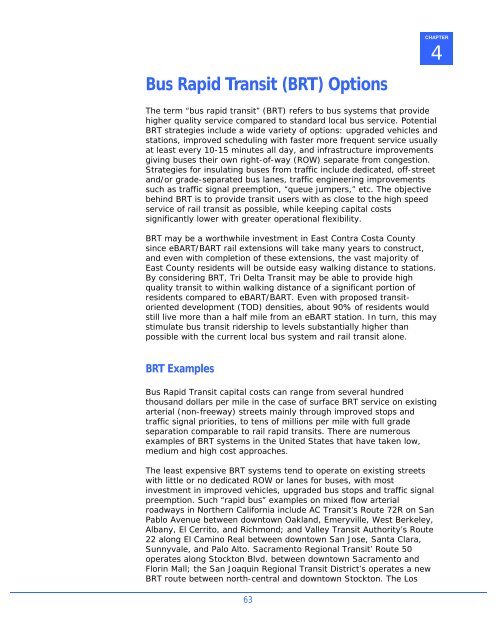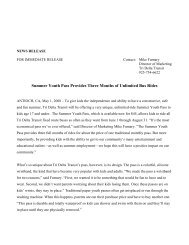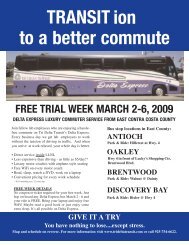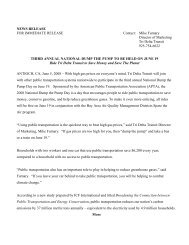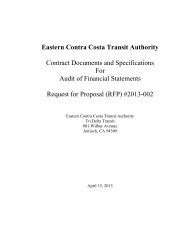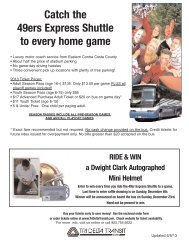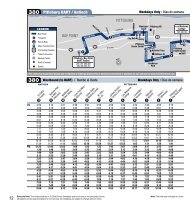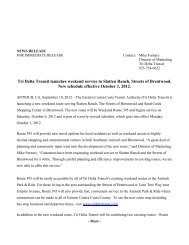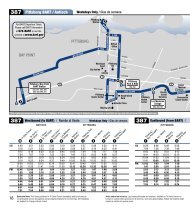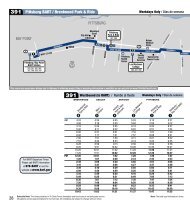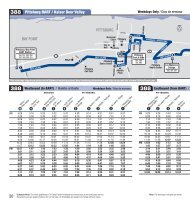to view Short Range Transit Plan FY 2007/2008 - Tri Delta Transit
to view Short Range Transit Plan FY 2007/2008 - Tri Delta Transit
to view Short Range Transit Plan FY 2007/2008 - Tri Delta Transit
You also want an ePaper? Increase the reach of your titles
YUMPU automatically turns print PDFs into web optimized ePapers that Google loves.
CHAPTER4Bus Rapid <strong>Transit</strong> (BRT) OptionsThe term “bus rapid transit” (BRT) refers <strong>to</strong> bus systems that providehigher quality service compared <strong>to</strong> standard local bus service. PotentialBRT strategies include a wide variety of options: upgraded vehicles andstations, improved scheduling with faster more frequent service usuallyat least every 10-15 minutes all day, and infrastructure improvementsgiving buses their own right-of-way (ROW) separate from congestion.Strategies for insulating buses from traffic include dedicated, off-streetand/or grade-separated bus lanes, traffic engineering improvementssuch as traffic signal preemption, “queue jumpers,” etc. The objectivebehind BRT is <strong>to</strong> provide transit users with as close <strong>to</strong> the high speedservice of rail transit as possible, while keeping capital costssignificantly lower with greater operational flexibility.BRT may be a worthwhile investment in East Contra Costa Countysince eBART/BART rail extensions will take many years <strong>to</strong> construct,and even with completion of these extensions, the vast majority ofEast County residents will be outside easy walking distance <strong>to</strong> stations.By considering BRT, <strong>Tri</strong> <strong>Delta</strong> <strong>Transit</strong> may be able <strong>to</strong> provide highquality transit <strong>to</strong> within walking distance of a significant portion ofresidents compared <strong>to</strong> eBART/BART. Even with proposed transi<strong>to</strong>rienteddevelopment (TOD) densities, about 90% of residents wouldstill live more than a half mile from an eBART station. In turn, this maystimulate bus transit ridership <strong>to</strong> levels substantially higher thanpossible with the current local bus system and rail transit alone.BRT ExamplesBus Rapid <strong>Transit</strong> capital costs can range from several hundredthousand dollars per mile in the case of surface BRT service on existingarterial (non-freeway) streets mainly through improved s<strong>to</strong>ps andtraffic signal priorities, <strong>to</strong> tens of millions per mile with full gradeseparation comparable <strong>to</strong> rail rapid transits. There are numerousexamples of BRT systems in the United States that have taken low,medium and high cost approaches.The least expensive BRT systems tend <strong>to</strong> operate on existing streetswith little or no dedicated ROW or lanes for buses, with mostinvestment in improved vehicles, upgraded bus s<strong>to</strong>ps and traffic signalpreemption. Such “rapid bus” examples on mixed flow arterialroadways in Northern California include AC <strong>Transit</strong>’s Route 72R on SanPablo Avenue between down<strong>to</strong>wn Oakland, Emeryville, West Berkeley,Albany, El Cerri<strong>to</strong>, and Richmond; and Valley <strong>Transit</strong> Authority’s Route22 along El Camino Real between down<strong>to</strong>wn San Jose, Santa Clara,Sunnyvale, and Palo Al<strong>to</strong>. Sacramen<strong>to</strong> Regional <strong>Transit</strong>’ Route 50operates along S<strong>to</strong>ck<strong>to</strong>n Blvd. between down<strong>to</strong>wn Sacramen<strong>to</strong> andFlorin Mall; the San Joaquin Regional <strong>Transit</strong> District’s operates a newBRT route between north-central and down<strong>to</strong>wn S<strong>to</strong>ck<strong>to</strong>n. The Los63


